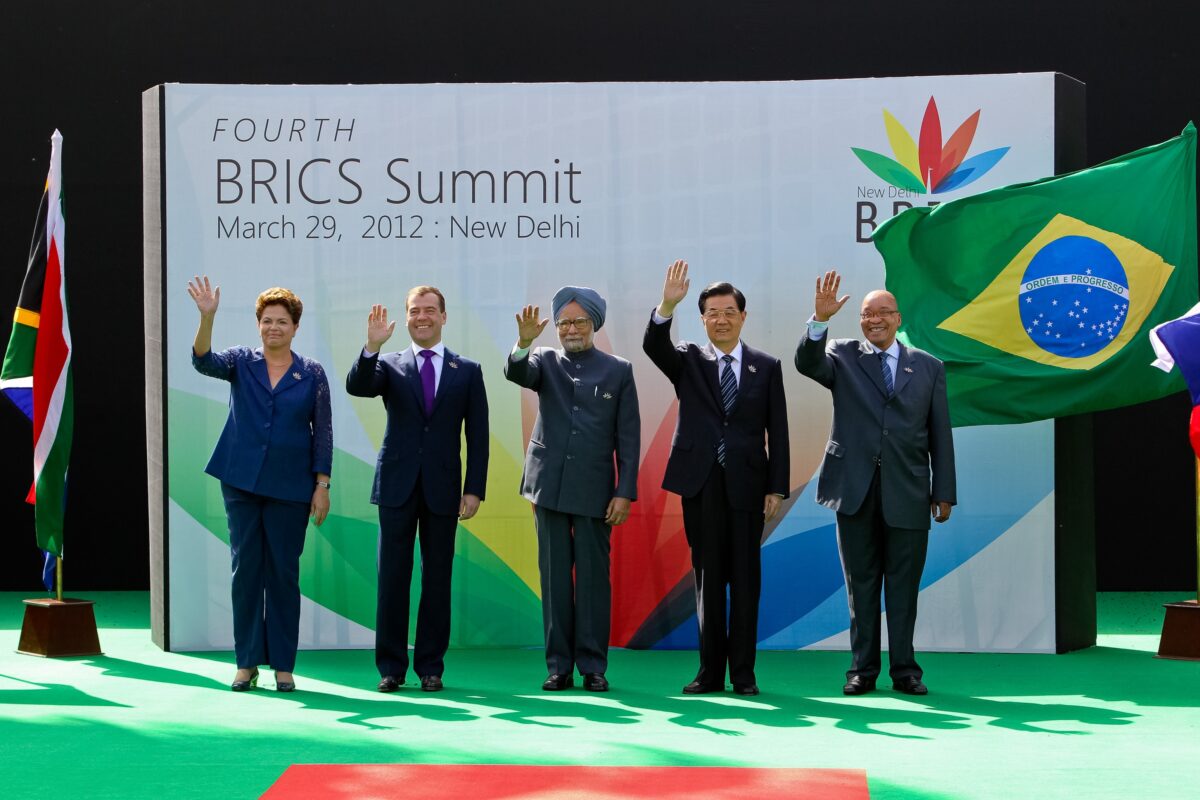Whatever Happened to BRICS
Global South
Hailed as the portent of a ‘golden decade’ in the flowery language of Xinhua, the China state news agency, the Brasília Declaration promulgated at the close of the last summit of BRICS heads of state or government in Brazil barely received mention in mainstream media. Brazil, Russia, India, China, and South Africa decided that innovation is the key to their future and agreed to strengthen cooperation in science and technology.
As the five leaders gathered mid-November last year for a remarkably low-key get-together to ponder the future, they also discussed ways to ensure the continued relevance of their initiative. Though the BRICS’ share of global GDP has steadily increased to about 32 percent (measured by purchasing power parity), and the countries jointly represent about 42 percent of the world’s population, the oddly divergent group has struggled to keep its momentum going.
Most investors and analysts have come to consider the loose union more of a marketing gimmick than a coherent grouping of tomorrow’s economic champions. As a geopolitical crowbar with which to rebalance outdated multilateral governance structures, BRICS undoubtedly has it uses. However, the group’s economic heft rests almost entirely on star performers China and India. Economic growth in Brazil, Russia, and South Africa has been lacklustre at best. Though the BRICS combined GDP has grown by 179 percent over the past decade, the lion’s share of that growth was registered in the group’s two largest member states.
Since the four founding members first met eleven years ago in Yekaterinburg – South Africa joined as a well-intentioned afterthought in 2010 – the BRICS economies have noticeably diverged their growth trajectories as is reflected in their credit ratings. Whilst China’s rating has climbed steadily to AA-, India, South Africa, and Russia are stuck around the still moderately respectable BB-mark as Brazil struggles to keep afloat in investment-grade territory.
Lacking a common denominator has apparently not prevented the group from sticking to the 15 commitments first formulated in Yekaterinburg. In fact, compliance as mapped by the BRICS Research Group, is remarkably high at 77 percent. The Economist Intelligence Unit found that, of the five member states, China is the most diligent in carrying out its obligations whilst South Africa has the most trouble keeping up.
No Surprise
These findings should come as no surprise. At the time, the inclusion of South Africa in the group was seen as a largely symbolical gesture meant to open a political gateway to the promising continent. Though China is very much a presence in Africa, other extra-regional BRICS member states are not. Interestingly, the odd one out South Africa is currently also the lone member not suffering a bout of authoritarianism.
Since President Jair Bolsonaro of Brazil rolled out his right wing agenda last year, and started cosying up to the US Trump Administration, the political influence of the BRICS as a group on the world stage has waned slightly due to the loss of unanimity in its sense of purpose – i.e. breaking the global dominance of the US, and to a lesser extent that of the EU.
In a note to investors released late last year, S&P Global Ratings surmised that the group has indeed lost relevance as investors fail to see the attraction. Jim O’Neill, the Goldman Sachs analyst who coined the acronym in 2001, agrees: “The diverging long-term economic trajectory of the five countries weakens the analytical value of viewing the BRICS as a coherent economic grouping.”
At the time, Mr O’Neill believed that the original four economies would move alongside the US as the biggest in the world. In this he was almost immediately seconded by Canadian economist Michael Spence, winner of the 2001 Nobel Memorial Prize in Economic Sciences, who predicted that the original BRIC member states before long would replace the United States and the European Union as drivers of the global economy.
Today, Mr O’Neill is considerably less optimistic and says that over the last decade the Brazilian and Russian economies have disappointed: “Both have clearly significantly under-performed compared with what the 2050 scenario path laid out.”
Useful as a forum, and certainly necessary as an expression of a paradigm shift in economic models and power, BRICS has proved useful and valuable to its member states. The New Development Bank (NDB), set up by the five in 2014 and based in Shanghai, financed a first tranche of projects two years later and now has a modest loan book of about $10.2 billion. However, the bank is usually counted amongst the world’s larger multilateral financial institutions with its paid-in capital of $100 billion. The bank has also set up a ‘contingency reserve arrangement’ for member states that need emergency funds, mimicking the special drawing rights of the International Momentary Fund (IMF), albeit with less strings attached.
Building on the success of the NDB, moves are afoot to launch a common payments system in order to conduct intra-BRICS trade in local currencies rather than in US dollars. According to Kirill Mitriev, head of the Russian Direct Investment Fund and member of the BRICS Business Council, the new system would tie in with a Moscow-backed initiative to develop an alternative to the SWIFT messaging service. Work on this has been ongoing since 2014 when Western nations slapped financial sanctions on Russia following its annexation of Crimea.
Mr Mitriev said that over the past few years Russia’s dollar-denominated trade has fallen from 92 percent of the total to slightly under 50 percent. Over that period, the share of cross-border trade settled in roubles has more than quadrupled to 14 percent.
Digital Economy
During their meeting in Brasília, the five leaders agreed to cooperate on shaping the ‘digital economy’ by boosting efforts to create a common ‘stable-coin’ cryptocurrency. China has taken the lead as that country is already far advanced with the development of its Central Bank Digital Currency (CBDC).
The practicalities of cooperation between BRICS members make mostly headlines in state sponsored media that usually celebrate lofty intentions more than actual accomplishments. This helps explain why the group barely features in the rest of the world. That, however, ignores the crucial geopolitical dimension of BRICS as a sustained attempt to overthrow, or at least radically modify, the post-war economic and financial order shaped at Bretton Woods, New Hampshire, in 1944. Investors may not be overly interested as they chase yield; most others ignore BRICS at their peril.
Originally conceived in the corridors of the Ministry of Foreign Affairs at Smolenskaya Square, one of the seven massive skyscrapers that Joseph Stalin ordered built to tower over Moscow, BRICS is the tangible expression of Russia’s long-cherished position as the ‘existential other’ vis-à-vis the western world – and normative order.
In her recent book Russia, BRICS, and the Disruption of Global Order, Rachel Salzman argues that whilst the group is no longer a ‘big story’ in global governance, the member states did succeed where the now almost-defunct Non-Aligned Movement failed: The BRICS countries managed to table their dissatisfaction with western hegemony in a constructive and serious manner, transforming the image of the global liberal order without appealing to questionable ideologies.
Ms Salzman, a visiting scholar at the Department of European and Eurasian Studies of the John Hopkins School of Advanced International Studies, suspects that much more than that may, however, not be expected. She points to the lack of coherence within the group and the divergence of the national objectives pursued by its five member states. This, Ms Salzman argues, must inevitably lead to a circular firing squad condition whereby cooperation breaks down and the western normative order prevails, remaining largely intact, not for lack of better options but because concerted resolve is hard to maintain between unequal partners.
© 2012 Photo by Agência Brasil


